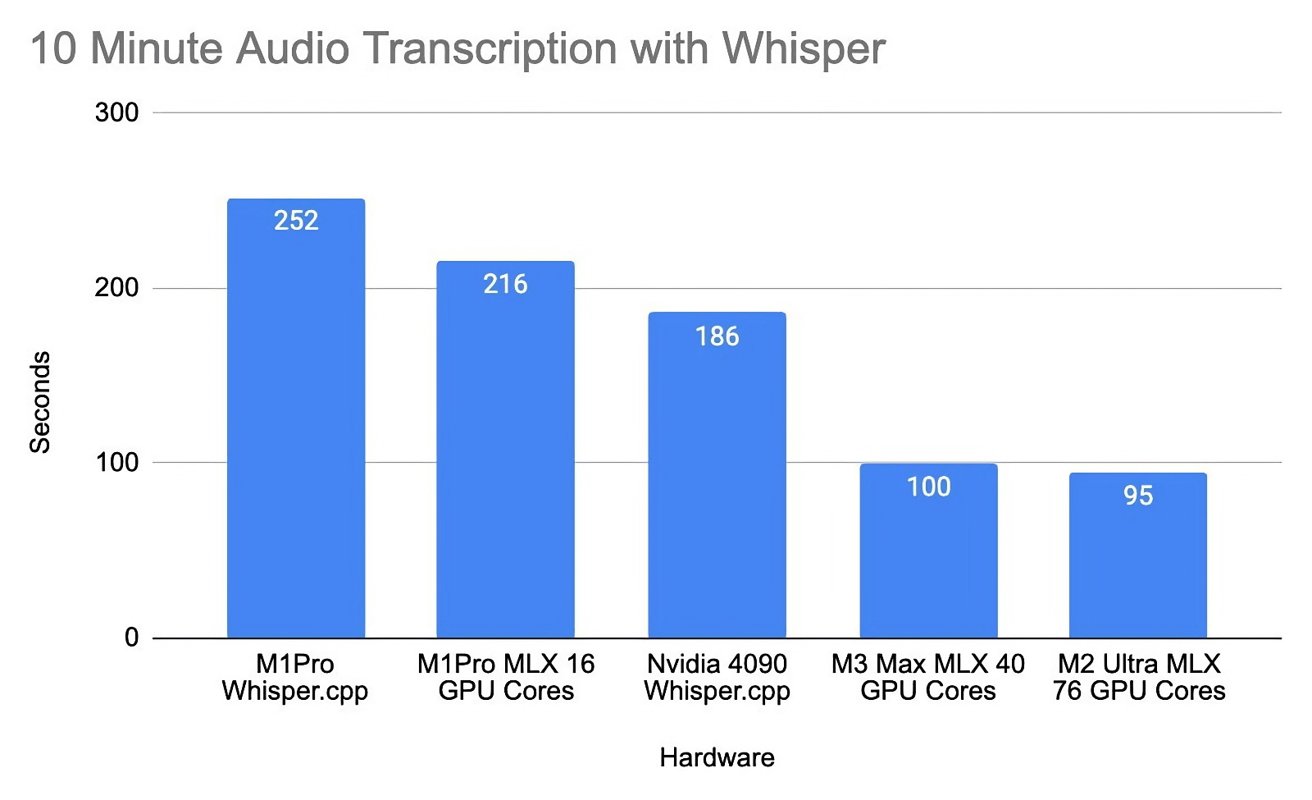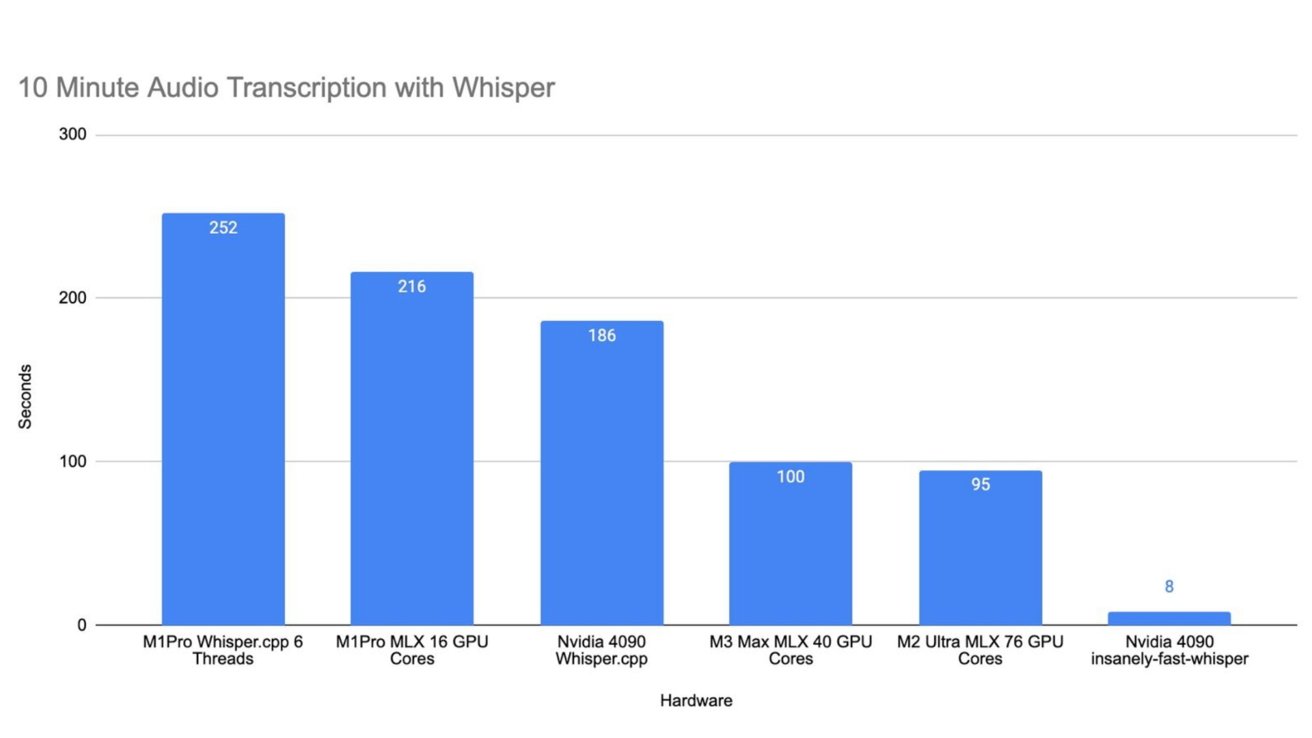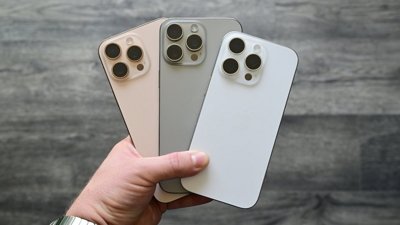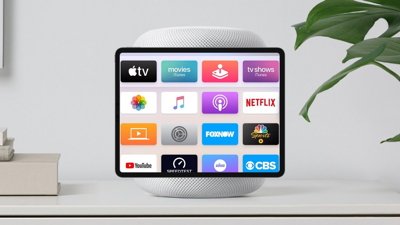In a recent test of Apple's MLX machine learning framework, a benchmark shows how the new Apple Silicon Macs compete with Nvidia's RTX 4090.
Apple announced on December 6 the release of MLX, an open-source framework designed explicitly for Apple silicon. It's meant for AI developers to build upon, test, use, and enhance within their projects.
Developer Oliver Wehrens recently shared some benchmark results for the MLX framework on Apple's M1 Pro, M2, and M3 chips compared to Nvidia's RTX 4090 graphics card. It makes use of Whisper, OpenAI's speech recognition model.
Wehrens uses the Whisper model for transcribing speech and measures the time it takes to process a 10-minute audio file. Results show that the M1 Pro chip doesn't quite meet the Nvidia GPU's performance, taking 216 seconds to process the audio compared to the 4090's 186 seconds.
However, newer Apple chips have much better performance. For instance, a different person ran the same audio file on an M2 Ultra with 76 GPUs and an M3 Max featuring 40 GPUs and found that these chips transcribed the audio transcription in less time than the Nvidia GPU.
There is also a significant difference in power consumption between Apple's chips and Nvidia's offering. Specifically, when comparing the power usage of a PC with an Nvidia 4090 running versus its idle state, there's an increase of 242 watts.
In contrast, a MacBook with 16 M1 GPU cores shows a much smaller increase in power usage when active compared to its idle state, with a difference of just 38 watts.
The results highlight Apple's gains in AI and machine learning capabilities and could be the beginning of better capabilities for Apple products. With the MLX framework now open-source, it paves the way for broader application and innovation for developers.
Nvidia's 4090 GPU starts at $1,599 just for the card, without a PC. This is the same price as the M3 MacBook Pro from 2022 — but prices increase rapidly for M3 Pro and M3 Max.
Using an optimized tool changed the results
An update to Wehrens' blog post changed the story. The M3 chips still performed well, but Nvidia cut its times by more than half when using appropriately optimized benchmark tools.
We're leaving the original story intact since it reflects how the non-optimized tool performed. However, Apple's processors still have a way to go to match Nvidia's when it comes to AI transcripts.
The most interesting factor to note is the difference in power consumption. That result didn't change — Apple's chips performed well at a fraction of Nvidia's power draw.
With the new results from the Nvidia-optimized tool, the transcript is completed in 8 seconds. M1 Pro took 263 seconds, M2 Ultra took 95 seconds, and M3 Max took 100 seconds.
Apple's results were still impressive, given the power draw, but still didn't match Nvidia's. Apple Silicon still has some room to improve, but it's getting there.
Updated December 13, 6:50 p.m. ET: Original post used a non-optimized benchmark showing inaccurate results.
 Andrew Orr
Andrew Orr








-m.jpg)






 Charles Martin
Charles Martin

 Wesley Hilliard
Wesley Hilliard
 Stephen Silver
Stephen Silver
 William Gallagher
William Gallagher

 Marko Zivkovic
Marko Zivkovic










21 Comments
One of the big advantages of Apple's "unified" memory approach is that you do not need to be continually shuffling data to and from the GPU and worrying if the GPU has enough memory. That's why although a GPU might have a theoretical GFLOP rating that is much higher than say a M series chip, in the real world, not so much.
- allocate memory for matrix A, B, C on the GPU
- copy data from main memory A,B to A,B on the GPU
- call GPU to multiply and compute C
- Copy matrix C from GPU back to main memory
He updated the article with the nvidia optimized version of whisper, and no surprise, the 4090 blows aways the macs. Still a nice trajectory that apple is on, but also still a long way to go.
Super interesting and it is clear that Apple is making headway and that the MLX release was a great thing for the community.
Comparison, while entertaining, is a bit misleading tho as it is comparing one architecture that is optimised for power efficiency against a plugged-in no holds barred GPU architecture. To say that Apple has a long way to go missed the point a bit.
The power consumption factor should be highlighted even more. The Apple benchmark is likely similar or the same if running plugged in or on battery. All-in the PC guts power consumption is likely 10x (or higher) of the M3 Max SoC. So if doing an amateur Watts x seconds calculation then the optimised Nvidia model is still faster than the MLX M3Max, but not by a whole lot at all.
RTX 4090 has a TDP of 450W. Laptop RTX 4090 is 175W (?). M3Max is far from this and Nvidia GPU power draw is not counting the PC CPU, RAM and other circuitry that resides in the M3 chip.
Now I wonder if there is any option to do a MLX version of the Nvidia optimised model. Perhaps there are many other tweaks in the model besides tuning it for Nvidia cards?
Also I wonder what performance numbers we would see if Apple would go on a ragga tip and do an M3 chip with a TDP of 450-700W. Maybe Apple has tried it and it didn't meet expectations. Chips be hard.
Hopefully M4 will be tripling down on genAI performance.
Have I missed something?
The headline says M3 Pro competes with....
The article doesn't list the performance of the M3 Pro
M3 Max yes
M1 Pro yes
M2 Ultra yes